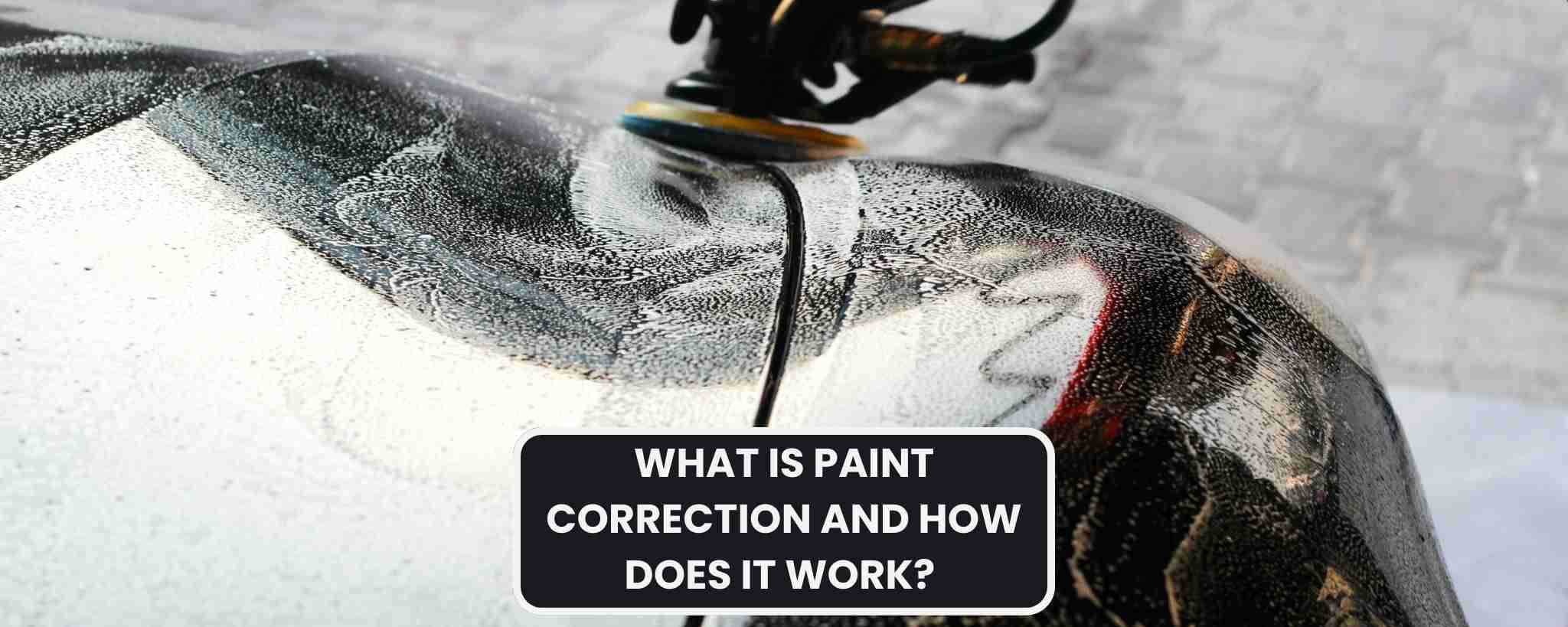What is Paint Correction and How Does it Work | Everything You Need To Know About Paint Correction
Paint correction is a process of removing scratches, swirl marks, and oxidation from your car's paint. But how does it work to eliminate all the imperfections!? Get your answers here!

Written by:
Parham Koukia
Reviewed By:
Editorial Team
Published: April 28, 2025
Updated: October 09, 2025
Use AI to summarize this article:
Paint correction is the process of removing imperfections in a car’s clear coat using specialized machines, pads, and abrasive compounds. This technique eliminates scratches, swirl marks, oxidation, and other blemishes to restore the paintwork to its original smooth and shiny finish.
It’s important to note that paint correction doesn’t involve repainting. Unlike temporary fillers or glazes, correction physically alters the clear coat by microscopically shaving down the top layer to create a uniform, reflective finish. Paint correction is not a single product or tool, it’s a multi-stage procedure that requires skill, experience, and the right tools for the paint system at hand.
How is Paint Correction Different From Polishing, Buffing, or Waxing?
Unlike traditional car detailing methods like buffing or waxing, paint correction focuses on permanent removal rather than temporary masking. For instance:
- Buffing smooths out minor imperfections, often without addressing deeper problems.
- Waxing provides a protective, glossy layer but doesn’t fix surface damage.
- Polishing can enhance shine, but it often lacks the precision needed for thorough correction.
Paint correction, on the other hand, is measured and permanent. It’s the only method that physically removes defects, rather than hiding them.
Why Do Paint Imperfections Occur?
Before understanding how paint correction works, it’s important to know why these imperfections happen in the first place. Clear coat damage can result from many sources:
- Swirl Marks: Often caused by improper washing or using dirty towels, swirl marks are light scratches that resemble spiderwebs.
- Scratches: Scratches can result from contact with tree branches, car keys, shopping carts, or even as an act of vandalism in parking lots and public areas.
- Oxidation: Prolonged exposure to the sun’s UV rays can cause paint to fade and lose its vibrancy.
- Environmental Contaminants: Bird droppings, bug splatters, and hard water spots can etch into the clear coat over time.
How Does Paint Correction Work? (Step-by-Step)
Paint correction is a detailed, multi-step process. Each step ensures the best results, transforming the car’s paint from dull and damaged to polished and flawless.
Here’s how paint correction works:
1. Surface Inspection and Paint Depth Measurement
Before starting, professionals inspect the entire vehicle for imperfections and measure the paint’s thickness with a paint thickness gauge. This helps to assess whether correction is safe and what level of abrasives can be used without damaging the paint system.
2. Decontamination (Clay Bar, Iron Removers, and Pre-Wash)
Decontamination of the surface eliminates dirt, tar, iron particles, and other bonded contaminants. Techniques for decontamination include:
- Clay Bar Treatment: Removes embedded debris from the paint surface.
- Iron Fallout Removers: Dissolve microscopic metal particles for a deep clean.
- Prep Wash: Clears surface contaminants, ensuring no harsh particles scratch the paint during correction.
3. Machine Polishing (Compounding and Finishing)
Correction begins with a compounding stage, where abrasive compounds and cutting pads remove deep defects. The surface is then refined with a finishing polish and softer pad to restore clarity and reduce haze.
4. Paint Thickness Monitoring and Refinement Techniques
Throughout the correction process, detailers monitor paint thickness to avoid over-polishing. Techniques like tape-line testing and spot-correction are used to control abrasion and preserve paint integrity. Professionals adjust pad density, machine speed, and arm pressure based on panel condition and paint type.
5. Post-Correction Protection
Once the correction is complete, a protective layer is applied to prevent future damage. Popular options of paint protection include:
- Ceramic Coatings: Offer long-lasting, high-durability protection against UV rays, scratches, and contaminants.
- Paint Sealants: Provide a temporary protective barrier for up to six months.
- Waxes: Add a glossy finish, but typically last only a few weeks.

Tools and Products Used in Paint Correction
Professional-grade paint correction requires specialized tools. Here’s a breakdown of the tools used in the paint correction process:
DA Polishers vs. Rotary Polishers
- Dual-Action (DA) Polishers are forgiving and user-friendly, making them ideal for beginners.
- Rotary Polishers are more powerful and suited for addressing severe imperfections, but they require professional skill to avoid burns and holograms.
Types of Polishing Pads
Polishing pads come in different materials, each for specific tasks:
- Foam Pads: For general polishing and finishing. Ideal for one-step correction.
- Microfiber Pads: Aggressive and suitable for cutting through tougher imperfections.
- Wool Pads: For deep corrections when working with heavy cutting compounds.
Polishing Compounds and Abrasives
Polishing compounds vary in their abrasiveness:
- Cutting Compounds tackle heavy scratches and defects.
- Finishing Polishes smooth out the surface for a glass-like finish.
What to Expect from Paint Correction?
The results of paint correction can be stunning, but we want you to set realistic expectations after your first paint correction.
Before and After: Realistic Expectations
Despite making your car shine like new, paint correction has some limits. It cannot remove defects beneath the clear coat or correct paint failures like clear coat delamination.
However, a properly corrected surface will show significant improvements in gloss, depth, and clarity.
How Long Do Paint Correction Last Without Additional Protection
Without protection, corrected paint is vulnerable to recontamination and UV degradation. The finish may begin to degrade within weeks. Applying a coating extends the life of the correction by months or years, depending on the product used.
Common Misconceptions About “Permanent” Correction
Paint correction is permanent only in the sense that removed defects do not return. However, new defects can appear if the vehicle is washed or maintained improperly. There’s no such thing as “maintenance-free” correction.
Is Paint Correction Right for You?
Paint correction isn’t for everyone. It’s especially beneficial for:
- Used Car Buyers: Paint correction is an affordable alternative to repainting and can restore the factory finish on a used car.
- Car Enthusiasts preparing for shows or applying ceramic coatings: Correction maximizes surface clarity, ensuring coatings bond properly and reflect light evenly under show lights.
- Daily Drivers: Paint correction improves gloss and makes maintenance easier for daily drivers.
Is Paint Correction Worth the Cost?
Average Pricing of Paint Correction by Stage
Here’s the approximate prices of paint correction by stage. While the upfront cost may seem high, it’s often more cost-effective than repainting.
- One-Step Correction: $300–$600 (removes light swirl marks and minor blemishes).
- Two-Step Correction: $600–$1,000 (eliminates moderate to severe imperfections).
- Multi-Stage Correction: $1,000+ (for extensive damage).
Prices may vary by region, detailer experience, and vehicle condition.
Value Comparison
- Repainting can cost several thousand dollars and may not retain the original factory quality.
- Paint Correction preserves the factory finish while achieving a like-new appearance.
Risks, Myths, and Common Mistakes
Over-Polishing and Clear Coat Damage
Each polish removes microns of clear coat. Over-polishing over time can thin the surface and increase the risk of UV damage or failure.
“One and Done” Correction Myth
Paint correction is not a one-size-fits-all service. Vehicles age, and surfaces degrade. Maintenance polishing may be needed after several years, depending on care habits.
Why DIY Kits Rarely Match Professional Outcomes
Most consumer kits lack the pad variety, machine power, and abrasives required for real correction. They also skip steps like decontamination and surface inspection, risking damage.
Booking a Professional
Before you book, ask your detailer about their process, tools, and protective options. And if you decide to invest in this procedure, be sure to maintain your corrected paint with regular washing and proper protection for long-lasting results.
For the best results get a professional detailing service from experts, who know how to do handle your car's paint with care!

Parham Koukia
Lead Car Detailer / Operations Manager
With nearly 15 years of hands-on detailing experience, Parham has become a trusted authority in the auto care world. His work is regularly spotlighted in leading outlets like CNN, GoBankingRates, and Family Handyman. Parham likes to share his knowledge to offer in-depth tips on equipment selections, seasonal car care, and some secret car cleaning tips used by detailers in the real world!
Read more
